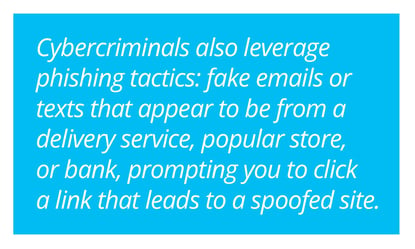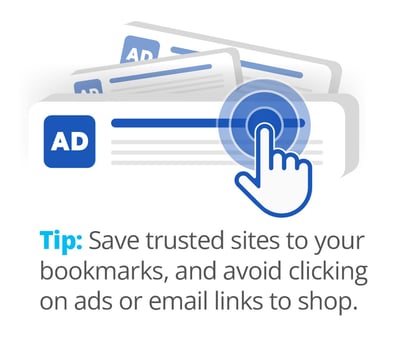Table of Contents
1. What Are Fake Websites, and Why Are They So Dangerous?
2. Spot the Scam: How to Tell a Site Might Be Fake
3. Member Checklist: How to Shop Smarter and Safer Online
4. What to Do If You’ve Been Scammed
5. Best Practices for Safe Online Shopping
6. Keep It Real and Keep It Safe With Addition Financial
With the prevalence and preference for online shopping, online shopping scams continue to rise, even tricking savvy shoppers into losing money or personal information. What you might not realize is, this is a form of fraud. It is important to remain vigilant even before clicking “add to cart” or “pay now.” Staying safe online against potential scams can keep your money secure and your personal information locked down.
What Fake Websites Are, and Why They Are So Dangerous
Fake websites aren’t just an internet nuisance; they’re a sophisticated tool used by cybercriminals to commit fraud. These sites are often disguised as legitimate retailers, well-known brands, or urgent flash sale platforms. Their purpose? To steal your money, your personal information, or both.
Fake websites are more common than you might think. With the continued growth of online shopping, scammers have doubled down on creating realistic-looking pages that mimic trusted businesses. Some are built from scratch, while others clone actual sites, right down to the logo and product descriptions. These sites can appear through fake ads on social media, in search engine results, or even through phishing emails that push you to act fast.

Why are they so hard to spot?
They’re built to deceive. These pages often use professional-looking designs, countdown timers, or unbelievable discounts to create urgency. And once you enter your payment info, the scammers vanish, leaving you with nothing but a fraudulent charge.
Cybercriminals also leverage phishing tactics: fake emails or texts that appear to be from a delivery service, popular store, or bank, prompting you to click a link that leads to a spoofed site. One wrong click can result in compromised accounts or identity theft. This is why education and caution are your first lines of defense.
Spot the Scam: How to Tell a Site Might Be Fake
Recognizing a potential scam before you fall for it can save you time, money, and stress. Here are key signs to help you determine whether a website is the real deal or a clever trap:
Suspicious URLs:
Check the address bar. Scammers often use lookalike domains like amaz0n.net or n1kedeals.com to mimic real brands. Watch for misspellings, extra characters, or strange endings (like .store or .top when it should be .com).
Design Doesn’t Match a Legitimate Company:
If the website is poorly designed, full of grammar errors, has low-resolution images, or has broken links, it may not be what it claims to be. Reputable businesses typically invest in clean, professional digital storefronts.
Fake Reviews & Too-Good-to-Be-True Prices:
Be wary of websites that showcase glowing fake reviews or products listed at prices far below market value. If it seems too good to be true, it likely is. Scammers rely on urgency and big promises to catch unsuspecting buyers.
No Contact Info or Customer Service:
A legitimate company will always offer a way to contact them, whether by phone, email, or live chat. If the site lacks this, or only has a form with no listed address or number, that’s a major red flag.
When in doubt, reach out to the retailer directly or use known, verified websites for your online shopping.
Member Checklist: How to Shop Smarter and Safer Online
Before you buy, ask yourself:
- Does the website URL start with “https://” and show a lock icon?
- Have I researched this company through trusted review sites or the BBB?

- Is the price way lower than what I’ve seen elsewhere? If so, why?
- Is there real contact info and a clear return policy?
- Did I find this through a fake ad or phishing email/text?
- Am I using a credit card for purchase protection?
What to Do If You’ve Been Scammed
Even the most cautious shoppers can slip up, and you’re not alone. If you think you’ve entered personal or payment information on a fake website:
- Immediately report the charge to Addition Financial or your card provider. You may be able to stop the transaction or receive a refund for fraudulent charges.
- Change your passwords, especially if you used the same one elsewhere.
- Monitor your accounts for any suspicious activity over the coming weeks.
- Report the scam to the FTC.
- Reach out to Addition Financial’s member support to ensure your accounts are protected and to learn more about the fraud monitoring services we offer.
Best Practices for Safe Online Shopping
Setting up best practices whenever you choose to browse online is a great way to stay ahead of scammers. One best practice should be to use credit cards instead of debit cards when you are processing a payment. Credit cards offer more protection, like zero liability, and there is less of a risk to your bank account.

When a debit card is compromised, funds are directly removed from your linked bank account, potentially leading to overdrafts and other financial difficulties while the fraud is investigated. With a credit card, the fraudulent charges don't immediately impact your checking account, offering a buffer. Additional card features like alerts, holding payments, and simply processing disputes create an easier situation if you have found yourself a victim of a scam or fraudulent charge.
Always avoid clicking on ads; you should always go directly to a brand’s website. The direct route is always the best when trying to shop online. Ads can be fake fronts for legitimate websites that are duplicating their information to pull in potential customers. Similarly, phishing emails or texts will use fake order confirmations, shipping alerts, or purchase thank-yous to prompt a clickthrough, where it may ask for information to confirm what order you are inquiring about. This can lead to loss of personal information and open you up to malware or viruses.
Keep It Real and Keep It Safe With Addition Financial
We encourage members to pause and evaluate before making a purchase online. Trust your instincts, and if something feels off, don’t proceed. Your safety is our top priority, and that commitment shines through our comprehensive Security Center. We’ve also partnered with KnowBe4, a company that specializes in educating people about online security, and you have access to our courses by being a member of

Addition Financial Credit Union. Access these courses by signing in to Digital Banking, then select "Internet Security Education" under your accounts.
Addition Financial also has a catalog of additional blogs about fraud for you to explore. This month, we are thinking about the future of your finances and being prepared, and our Emergency Savings Plan Builder is a great tool to guide you through saving for other kinds of unexpected life events beyond online scams. With all of these resources, we hope we can be an effective partner in your financial life.
/AFCU_93-EmergencySavingsPlan-CTA.jpg?width=1143&height=262&name=AFCU_93-EmergencySavingsPlan-CTA.jpg)





/AFCU_93-EmergencySavingsPlan-CTA.jpg?width=1143&height=262&name=AFCU_93-EmergencySavingsPlan-CTA.jpg)